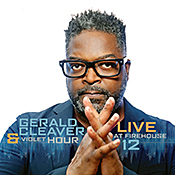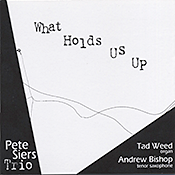Recent Recordings by Area Jazz Artists
Drummer and composer Gerald Cleaver has been in demand by bandleaders since his days in Detroit, but is also a leader of several musical groups, including Uncle June, Black Host, and the septet Violet Hour. The last of these draws upon current and former members of the Detroit area scene, consisting of Andrew Bishop (soprano saxophone, bass clarinet, tenor saxophone), J. D. Allen (tenor saxophone), Jeremy Pelt (trumpet), Ben Waltzer (piano), Chris Lightcap (bass), and the leader on drums. The combo was featured on the 2007 studio album Detroit (Fresh Sounds), and has just released a new one, this time recorded in concert in New Haven, Connecticut, entitled Live at Firehouse 12 (Sunnyside SSC1565).
During this performance, Cleaver revisited five of his compositions from the previous album, and it is obvious that time has done nothing to harm the effectiveness of the material. This is a blowing session and all the participants clearly came to play with vigor. The solos are inspired throughout, with nice contrasts between the tenor saxophone styles of Allen and Bishop, the latter also impressing on soprano sax and particularly on the bass clarinet. Pelt plays with exhilaration, sometimes recalling the excitement offered by Freddie Hubbard in his prime, and the rhythm section drives hard throughout.
There is much variety here. Bishop’s various horns provide textural accents, and the collective passages and backgrounds behind soloists serve the music well. Cleaver and his cohorts can perform in a wide range of styles, from traditional jazz to widest borders of experimental music, but this is a testament to their love of straight ahead swinging, blowing jazz — even if on occasion they take the music into some of the outer limits.
Andrew Bishop appears again, albeit solely on tenor sax, on What Holds Us Up (PKO 080) by the Pete Siers Trio, with the leader on drums and Tad Weed on electric organ. The lineup seems to harken back to the classic tenor sax/organ trios of the middle of the last century, but this was definitely an update of the genre for our time. All three of the musicians have experience with the full range of jazz history and embrace a range of traditions to create something quite new here.
The recital begins with Frank Catalano’s “Big Al’s Theme and Soul Dream,” but rather than a fast-paced head-on back-beat heavy riff soul tune, we hear the organ’s punctual notes with the saxophone exploring out sounds over it. Only slowly does the trio move into a groove and play the theme, much slower and funkier than the original. Throughout, Bishop creates a tense with his full use of the full range of the tenor, from top to bottom, with judicious use of extended techniques. Here, as throughout, the rich beauty of his unique instrumental sound, well captured by recording engineer Eric Sills, is well on offer. When Weed steps up to solo, he begins with classic soul organ, only to move on to more modern textures and harmonies, all the while swinging hard, propelled by Siers’ strong drums.
When tackling Thelonious Monk’s “Let’s Cool One,” one of his harmonically simplest tunes (based on the changes of “Just You Just Me”), the musicians avoid the obvious head-solos-head format. The tune begins out of tempo, with no obvious reference to what will follow. Weed finds some extreme sound on the organ only to move into a more traditional groove, with Bishop creating new melodies on the chord structure and it is only halfway through the song that hints are provided to its identity, only to move on to more harmonically rich explorations that move into distant territories and end on some perfectly timed extreme sounds. This is not so much “Let’s Cool One” as a compositionally varied but well-structured set of variations that explore this well-known song without ever precisely stating the theme (their adaptation of “Monk’s Dream” is similarly original).
Leroy Vinegar’s pensive “For Carl,” written in the memory of the pianist Carl Perkins, on the other hand, sticks perfectly to the melody, played with a longing sound by Bishop, with swinging, more mainstream in-the pocket solos. By the time we get to the final “Polkadots and Moonbeams,” it is a late night at the club, and everyone is in a laid-back ballad mood, satisfied with great music making and ready to pack it up and go home.
There are so many fine recordings issued every month that recitals like this one go unnoticed, which would be a shame as it presents a unique element in the discographies of all members of the trio, who seem to share original and complex compositional approaches. For Siers, it is one of the few documents of the more experimental side of his playing. For Bishop it is a fine example of his tremendous command of the tenor, of his seemingly unending technical resources, and of the emotionally embodied singularity of his sound. Hearing Tad Weed on the organ rather than his usual piano is a revelation; he seems to revel in the sonic possibilities of the instrument. Sadly, however, this may be the last document of his amazing musicianship on record as he left us only three months later. Listening to him here, one would never know how ill he was—his artistic commitment seems never to lag, and it serves as only one more reminder of how much he is missed by so many in our community.


